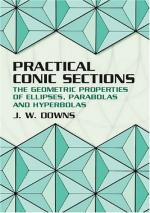|
This section contains 1,150 words (approx. 4 pages at 300 words per page) |

|
A hyperbola is a curve formed by the intersection of a right circular cone and a plane. When the plane cuts both nappes of the cone, the intersection is a hyperbola. Because the plane is cutting two nappes, the curve it forms has two U-shaped branches opening in opposite directions.
A hyperbola can be defined in several other ways, all of them mathematically equivalent:
1. A hyperbola is a set of points P such that PF1 - PF2 = ± C, where C is a constant and F1 and F2 are fixed points called the "foci." That is, a hyperbola is the set of points the difference of whose distances from two fixed points is constant.
The positive value of ± C gives one branch of the hyperbola; the negative value, the other branch.
2. A hyperbola is a set of points whose distances from a fixed point (the "focus") and a fixed...
|
This section contains 1,150 words (approx. 4 pages at 300 words per page) |

|


